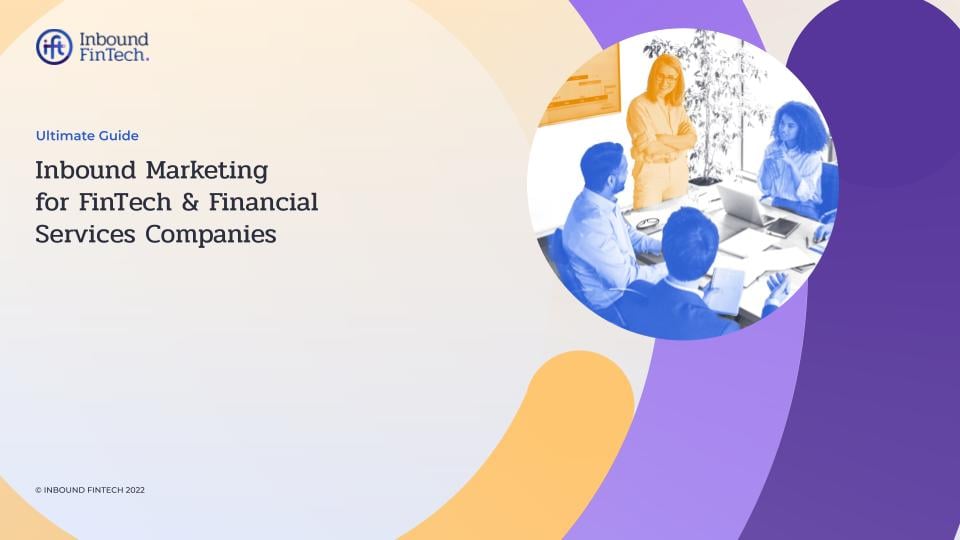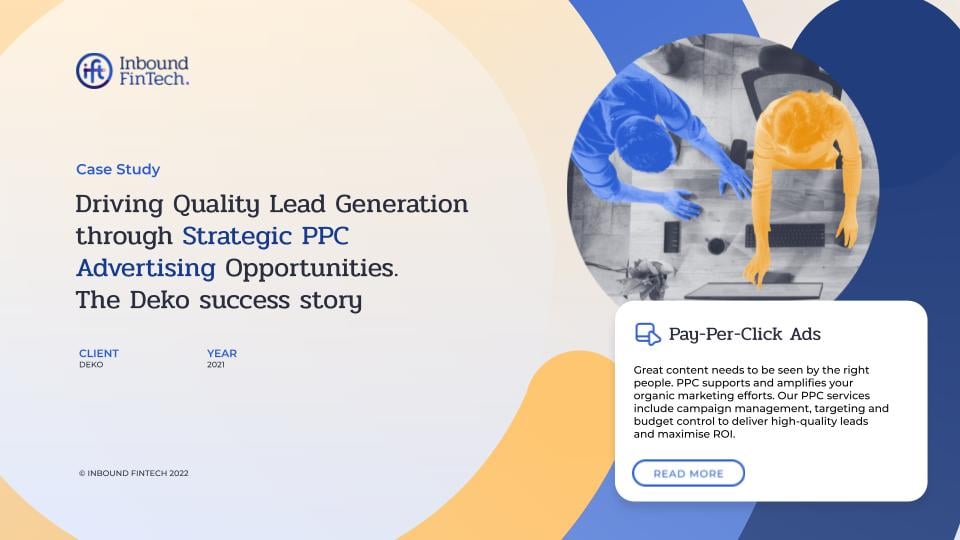Like many digital marketing disciplines, search engine optimisation (SEO) is always evolving. As it plays a fundamental role in marketing success, from content planning and brand awareness to lead generation and nurturing, keeping pace with the top SEO trends is vital.
Inbound FinTech’s SEO experts have outlined 10 top SEO trends FinTech marketers need to know about, from search engine algorithms and content evaluation criteria to the tools and tactics that can help you drive high-quality leads to your website.
How has search engine optimisation (SEO) evolved in recent years?
One of the biggest factors that have impacted SEO in recent years is the increased search engine sophistication and Google’s greater emphasis on the quality of website content, including its structure and reliability. As Google hugely dominates the search engine market - as of July 2023, Google held almost 84% share of the global search engine market, with its closest competitor, Bing, holding close to 10% - marketers need to take this into account if they want key pages to rank highly in search results.
It’s not back to the drawing board per se, but the days of paint-by-numbers SEO content and simple keyword inclusion are over. Today, success requires a more strategic approach and well-structured content planning and creation, prioritising quality, relevance and trustworthiness.
Why SEO is more important than ever for FinTech and Financial Services companies
FinTech and Financial Services businesses have traditionally relied on events, word of mouth and affiliate marketing for lead generation. However, in an increasingly competitive market and fast-changing landscape, digital lead generation is vital for long-lasting success. And unless you have deep pockets for paid activity, driving organic leads is imperative. According to HubSpot’s 2022 State of Marketing Trends Report, SEO came out as second in the most effective channels for acquiring new customers and driving high-quality leads.
Websites can become lead-generating machines and do a lot of your nurturing work for you if you have a well-structured site, powered by UX, UI and CRO. But the key to opening the door to your personas (ideal customers) is an effective SEO strategy and a continuous improvement approach to content management.
For more insights, read our blog on the importance of SEO for Financial Services marketing. Or for a deep dive into SEO fundamentals, check out our Essential SEO Strategies Guide for Financial Services.
10 SEO trends FinTechs need to know
So, let’s dive into the latest search engine optimisation trends that are changing the game for marketers. Here are our 10 top SEO trends for FinTech companies to be aware of to attract, nurture and convert organic, high-quality leads.
1. Prioritising targeted, data-driven content
If you’re aware of inbound marketing or other customer-centric content marketing approaches, like Jobs to be Done or They Ask You Answer, you’ll know the underlying concept for successful content is aligning with the needs, pain points and goals of your target audience. And SEO and inbound marketing go hand in hand.
Every piece of content you create needs to have a clear purpose, target your personas’ search intent and be backed by research and analysis - only a data-driven approach will bear the right fruits for your Marketing and Sales teams.
2. Think bigger than just keywords
As mentioned, marketers must focus on creating quality, well-structured and helpful content - simple keyword optimisation is not enough. Consumers and search engines demand context and clear paths to the right information to match search intent.
When planning a piece of content, consider the bigger picture and always keep relevance and purpose in mind. However, don’t start thinking that keywords are no longer important. They are! Thorough keyword research and sophisticated optimisation are still vital, but your content’s quality, structure and readability are just as important.
3. AI and algorithms
As with social media networks, search engine algorithms are constantly being adjusted, largely with personalisation in mind. Meanwhile, AI and smart devices are also playing a role in steering top SEO trends, as voice search and predictive technology are changing the way search engines generate results.
Google's recent introduction of Search Generative Experience (SGE) is paving the way for AI-powered searches, offering users better, more enhanced search results - and the opportunity to ask follow-up questions for more accurate and tailored answers in a similar way to ChatGPT.
For marketers, these innovations mean adapting content to account for more question-based and conversational search queries and honing in on SEO best practices for a greater chance of appearing in AI-generated search results.
So, consider these factors when developing and refining your SEO and content strategies and keep abreast of Google’s latest algorithm updates to keep ahead of the curve.
4. Answering complex queries
In industries like Financial Services, which involve complicated concepts, search queries often need comprehensive answers. A simple definition or a few handy tips are unlikely to suffice. You need to be prepared to create content that answers complex questions.
There are several ways to go about this, including:
- Creating a series of articles which tackle various aspects of a complicated topic
- Developing a comprehensive piece of long-form content covering key queries and subtopics, backed by trusted sources and links out to further information
- Build a knowledge base or FAQs that provide answers to the most common (and complicated questions)
5. Incorporating E-E-A-T considerations
No, “EEAT” has nothing to do with food. It stands for experience, expertise, authoritativeness and trustworthiness. These are the key values that Google’s content evaluators are judging content on, beyond the structure and purpose of the content.
This is perhaps the most important of these top SEO trends, especially for FinTech and Financial Services marketers. Google places additional scrutiny on financial content and so-called YMYL (your money, your life) pages, as information on these pages can have a key impact on financial decision-making, therefore E-E-A-T factors are essential.
Learn more in SEMRush’s article on the topic of Google’s E-E-A-T and YMYL content evaluation.
6. Use of video content
The demand for video is at an all-time high. In 2023, video content accounts for 82.5% of all web traffic, and YouTube remains the second most popular social media platform with 2.7 billion active users - second only to Facebook which boasts a comparable 2.9 billion active users.
With AI, voice transcription and other algorithm adjustments relating to video content, video is becoming a key format for content marketing plans. With this continued growth in video views, consumers will increasingly expect to get information via video as part of their decision-making. And this needs to be reflected in SEO and content marketing strategies.
Both short- and long-form videos can be utilised to explain concepts and demonstrate products and services. You can embed them in a longer piece of content or use them as standalone content to answer a direct search query or offer expert insights on a particular topic.
Despite the growing popularity of TikTok, Instagram reels, video ads, etc, long-form content is the fastest-growing category of video. Uploads for videos between 30 and 60 minutes have nearly tripled since 2019, with webinars receiving the most engagement from viewers.
Looping back to number 4 on our top SEO trends list, videos can break down complex ideas and help people retain messages more effectively. It can help establish your brand and website as a trusted source of information and a thought leader in the Financial Services industry.
Check out this graphic from the report on the key business goals with video content creation:
7. Pillar pages and topic clusters
In recent years, pillar pages have emerged as a leading trend in inbound marketing strategies. These long-form content pieces can lay the foundation for your SEO content plans, as they tie different content together, powering your internal linking and driving leads to your website across a wide net of associated keywords.
Pillar pages are content hubs based around an important subject area for your organisation. And topic clusters feed into the main topic, covering various questions, tong-tail keywords - sprouting from the primary, broader keyword that the page is focused around - and linking out to supporting content (pages, blogs, videos, etc).
The purpose is to create rich insights and display thought leadership in a topic closely aligned with your business offering. Pillar pages educate your audience and provide options for leads to click through to gain further details about sub-topics covered on the page, depending on their position along the buyer's journey. This helps to build authority and improve keyword ranking.
See the graphic below, which demonstrates how the pillar pages and topic clusters align and how this can help you build out a content marketing plan.
8. Core Web Vitals & mobile responsiveness
The proportion of website searches via mobile has grown rapidly, catching up with desktop and laptop searches. And in November 2021, web page views from mobile phones accounted for over 47% of web traffic in the UK. This number is even higher in the US. Google has moved to accommodate this by prioritising mobile-friendliness, rewarding sites for mobile responsiveness and focusing on Core Web Vitals.
In May 2020, Google announced that page experience signals would become a key organic ranking factor, with its algorithm measuring various user experience metrics, such as:
- Mobile-friendliness
- Safe browsing
- HTTPS
- Content accessibility (page loading speed, lack of intrusive pop-ups, etc)
Then later that year, Google introduced three key Core Web Vitals metrics, which are:
- Largest Contentful Paint (LCP) - measuring loading performance
- First Input Delay (FID) - measuring interactivity
- Cumulative Layout Shift (CLS) - measuring visual stability
What does that mean for businesses and how can you ensure your website ticks these boxes? Your web development agency or team should be able to implement UX principles that align with Google’s expectations. Plus, the tools mentioned in the last of our top SEO trends can show you how your website performs on Core Web Vitals, identifying issues to address to reduce visitor frustration, improve their experience, drive conversions and boost SERP rankings.
For a deep dive, check out Search Engine Journal’s Complete Guide to Core Web Vitals.
9. Up your backlinking and outreach game
Often the forgotten part of SEO strategies - or the part businesses struggle to find time for - outreach and backlinking remain key cogs for driving website content authority. Yes, the research and implementation involved are time-consuming, but with a framework and efficient processes, backlinking strategies can take your SEO performance to the next level.
The key is establishing the most relevant and important sites and networks to target for gaining backlinks, targeting trusted sites with high domain authorities and where your personas are likely to seek information. Here are some steps you need to take:
- Define the content that you want to drive traffic to
- Establish what approach to take with each target, such as:
- organic outreach
- invite for collaboration/guest blogging
- free or paid placement
- PR enquiries
- account set up
- social posting, such as adding answers/threads to the likes for Quora/Reddit
- open forums/channels for syndication, like Medium
- Create a sheet to track your targets, progress and status
- Build templates for outreach to speed up the process
When working on your backlinking strategy, ensure you cite trustworthy information, as it will impact your own website’s reputation and ranking.
10. Utilising innovative tools to support your SEO efforts
Finally, to round up our top SEO trends list, it’s the software solutions that can power your success. Leverage some of the following SEO tools to enhance your strategy:
- Semrush - a vast array of research and analysis features to discover the right keywords to target, measure your success and site health and carry out site audits that reveal technical issues and how to address them.
- Ahrefs - a suite of tools helping businesses to identify areas to improve, inform keyword strategies, fix issues and compare performance with competitors.
- Moz - another popular solution for businesses offering analytical tools to improve link building, content marketing and search ranking.
- Screaming Frog - a powerful site crawler that identifies issues, such as broken links, missing meta details, robots, 404s, etc, and tracks key onsite data.
- Hotjar - although it's not strictly an SEO tool, Hotjar is a very useful platform for marketers looking to optimise their website content. It uses heat maps and other tracking features to highlight visitor activity and behavioural insights that can help you improve performance.
- CMS-based SEO tools (native and plugins) - certain CMS solutions have tools that assess pages and blogs and offer guidance for following best practices, from native tools in platforms like HubSpot or WordPress’ Yoast SEO plugin.
Summary
We hope these top SEO trends have given you food for thought and actionable insights to apply to your business website, content strategy and marketing campaigns. However, keeping your finger on the pulse and being aware of the latest trends, updates and approaches is one thing, but being able to implement them effectively is another.
If you need help from experienced search engine optimisation experts, we can support you. Explore Inbound FinTech’s SEO services for FSI businesses, or download our handy Essential SEO Strategies for Financial Services Guide to learn more.
NOTE: This blog was first published in September 2022 but has been updated in 2023 to reflect industry changes and recent SEO updates and trends.
Inbound FinTech (IFT) is an award-winning digital growth agency, based in London, UK, in the heart of the Financial District. Our experienced team of marketing specialists helps FinTech and Financial Services companies to drive high-quality leads and grow their business online. IFT is a Google partner and elite HubSpot agency.




%20(3).png)






















.png)


-1.png)




